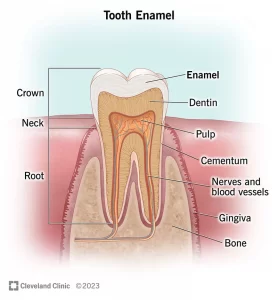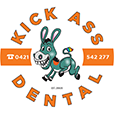What is the Enamel of the Teeth?
When it comes to dental health, the enamel of the teeth plays a vital role. Enamel is the outermost layer of the teeth and serves as a protective shield for the underlying dentin and pulp. This incredibly hard substance is composed mainly of minerals and is considered the hardest tissue in the human body. In this article, we will explore the structure, function, and importance of tooth enamel.
Structure of Tooth Enamel
To understand enamel better, let’s delve into its structure. Enamel consists of closely packed mineral crystals, primarily hydroxyapatite, which is a form of calcium phosphate. These crystals align themselves in a complex matrix, providing enamel with its characteristic strength. The mineral composition of enamel makes it highly resistant to wear and tear.
Underneath the enamel lies the dentin, a softer and less mineralized layer. Dentin is yellowish in color and forms the bulk of the tooth structure. The enamel covers the dentin, protecting it from external stimuli such as temperature changes, acids, and bacteria.
Functions of Enamel
The enamel serves several important functions in maintaining dental health:
1. Protection:
Enamel acts as a protective barrier for the underlying layers of the tooth. It shields the dentin and pulp from physical and chemical damage, preventing sensitivity and decay. The hard surface of enamel helps withstand the forces of chewing and biting.
2. Sensitivity Reduction:
Enamel plays a crucial role in reducing tooth sensitivity. Its mineralized structure acts as an insulator, preventing hot, cold, or sweet substances from reaching the nerves inside the tooth. When enamel is eroded or damaged, it can lead to tooth sensitivity and discomfort.

3. Aesthetics:
The color and translucency of enamel contribute to the visual appeal of a smile. Enamel is typically a white to off-white shade, and its smooth surface reflects light, giving teeth their shiny appearance.
4. Bite Force Distribution:
Enamel helps distribute the force of biting and chewing across the teeth evenly. By absorbing and distributing the pressure, enamel minimizes the risk of fractures or cracks in the underlying tooth structure.
Causes of Enamel Erosion
Despite its exceptional strength, enamel can still be susceptible to erosion. Various factors can contribute to enamel erosion:
1. Acidic Foods and Beverages:
Consuming acidic foods and beverages, such as citrus fruits, sodas, or vinegar-based dressings, can erode enamel over time. Acidic substances soften the enamel surface, making it more vulnerable to mechanical wear.
2. Tooth Grinding:
Habitual teeth grinding or clenching, known as bruxism, can gradually wear down the enamel. The excessive force exerted during grinding can lead to thinning of the enamel and potential fractures.
3. Acid Reflux Disease:
People with acid reflux disease often experience acid regurgitation, which can reach the mouth and come into contact with the teeth. The repeated exposure to stomach acid can erode enamel over time.
4. Poor Oral Hygiene:
Inadequate oral hygiene practices, such as infrequent brushing and flossing, can allow plaque to accumulate on the teeth. Plaque contains bacteria that produce acids, leading to enamel erosion and the formation of cavities.
Preventing Enamel Erosion
Protecting tooth enamel is essential for maintaining optimal dental health. Here are some preventive measures you can take:
1. Maintain Good Oral Hygiene:
Brush your teeth at least twice a day with a fluoride toothpaste. Use a soft-bristled toothbrush and gentle, circular motions to avoid damaging the enamel. Don’t forget to floss daily to remove plaque and food particles from between your teeth.
2. Limit Acidic Foods and Beverages:
Try to minimize your consumption of acidic foods and drinks. If you do indulge in them, rinse your mouth with water afterward to help neutralize the acid and protect your enamel.

3. Use a Straw:
When consuming acidic beverages like sodas or fruit juices, consider using a straw to minimize contact between the liquid and your teeth. This can help reduce the risk of enamel erosion.
4. Wear a Mouthguard:
If you grind or clench your teeth during sleep, wearing a mouthguard can help protect your enamel from excessive wear. Consult your dentist to have a custom mouthguard made for you.
5. Attend Regular Dental Check-ups:
Visit your dentist regularly for check-ups and professional cleanings. Your dentist can identify early signs of enamel erosion and provide appropriate guidance and treatments to prevent further damage. https://kickassdental.com.au/
Treating Enamel Erosion
If enamel erosion has already occurred, prompt treatment is necessary to prevent further complications. The appropriate treatment options depend on the severity of the erosion and may include:
1. Dental Bonding:
In minor cases of enamel erosion, dental bonding may be an effective solution. A tooth-colored resin is applied to the affected areas, restoring the appearance and protecting the exposed dentin.
2. Dental Veneers:
In more severe cases, where significant enamel loss has occurred, dental veneers may be recommended. These thin porcelain shells are custom-made and permanently bonded to the front surface of the teeth, improving their appearance and providing additional protection.
3. Dental Crowns:
For extensively damaged teeth, dental crowns may be necessary. Crowns are tooth-shaped caps that cover the entire visible portion of the tooth, providing strength, protection, and aesthetic improvement.
4. Fluoride Treatment:
Fluoride treatments can help remineralize and strengthen weakened enamel. Your dentist may apply fluoride gel or varnish to the affected teeth to promote enamel repair.
5. Lifestyle Changes:
It’s crucial to address the underlying causes of enamel erosion. This may involve modifying your diet, managing acid reflux disease, or seeking treatment for bruxism. By making these necessary lifestyle changes, you can help prevent further enamel erosion.
Conclusion
Tooth enamel is a remarkable substance that plays a crucial role in protecting our teeth. Understanding its structure, functions, and causes of erosion can empower us to take proactive steps in maintaining strong and healthy enamel. By practicing good oral hygiene, making smart dietary choices, and seeking professional dental care, we can safeguard our enamel and preserve our dental health for years to come.





